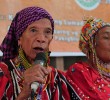After months of rebuilding communities through infrastructure and development, medical missions and community dialogues, and improved atmosphere of trust between the people and the government has evolved. This heightened level of interaction led to a constriction of the previously unhampered operations of the Abu Sayyaf group. Information on their whereabouts started to flow to our defence forces from the communities themselves and parallel to this development programs sustained combat operations on land and effective control of the surrounding seas further constricted the operational perimeter.
Naval units, in addition to their traditional roles, acted as law enforcers to control the sea. The enemies� traditional escape route from any area of land. Law and order at sea became the norm and this benefited the communities in the areas protected by our navy as they were able to go about their livelihood in peace.
It is this combination of development talent and military tools that led to the fall of the top leaders of the ESG.
Effective sea control, a greater intelligence, precise combat operations, sustained Government presence and multi-faceted development actions all contributed to the success of oplan ultimatum.
The positive outcome reflects the power of convergence of roles and authorities. This was all about defence led programs working in full measure to enable development goals.
Another particular project that dispersed was security and economic targets, is the pioneering [Cosworth South?]. This defence-led multi-agency arrangement for surveillance and response for the waters of Southern Philippines, responds to the need to secure Brunei, Indonesia, Malaysia, Philippines, East Asia growth, area potential for growth and development. This experience has lent credence to our proposition that defence for development makes even more sense on the regional scenario, particularly because mainly for citizens depend on this and need security to make a living and build their future.
Thus utilising defence actions for development purposes must be incorporated in defence policy making to which the Philippines has already taken the first step. Only when the strategic goal of institutionalising the maritime security structure for developing communities and nations in the region is in place can our national gains against our enemies be sustained.
We can confidently say that the region has already developed working templates for cooperation in securing regional waterways through the various bilateral arrangements. These interrelationships underscore the obvious: the time is right to secure this jointly, not only as military precaution, but as a national economic policy and an international interdependence initiative.
In closing, I go back to the topic at hand; the question of securing regional waterways is not only about how much we have done, but more importantly how much more we can do together. The answer to the question is also the challenge we must face together. The progress in securing regional waterways has been far-reaching with a multitude of partnerships now activated. The same progress and cooperative action must inspire us to build a larger alliance given our connectivity and the attendant inter-dependence that comes with it. Defence for development has an agenda and a vision for a truly regional maritime alliance captures the importance of maximising available defence resources on a communal basis for sheer growth and development results.
Now is the time to make collective might and means work to secure this is and enable more growth in the region, together it will work for us all on the level and within the square.










